*NURSING > QUESTIONS & ANSWERS > NUR 115 Final Test Bank, Questions/answers/Rationales (all chapters) Complete A+ guide (latest Fall (All)
NUR 115 Final Test Bank, Questions/answers/Rationales (all chapters) Complete A+ guide (latest Fall 2022)
Document Content and Description Below
NUR 115 Final Test Bank, Questions/answers/Rationales >Already rated A+ Latest Fall 2022/2023. NUR 115 Final Test Bank, Questions/answers/Rationales Chapter 09: Nursing Process: Your Role MULTIPLE CH... OICE 1. A student nurse asks, If RNs use a five-step nursing process and LPN/LVNs use a four-step process, what phase is missing? The best response would be, The phase of the nursing process that is the sole responsibility of the registered nurse is a. assessment. b. nursing diagnosis. c. planning. d. implementation. e. evaluation. ANS: B The LPN/LVN participates in all phases of the nursing process with the exception of establishing a nursing diagnosis. 2. The student nurse asks, How does knowing the nursing diagnosis assist the LPN/LVN? The best response is based on understanding that a. a nursing diagnosis identifies the patients problems. b. it permits the practical nurse to go beyond the scope of practice. c. this step makes the practical nurse equal to the medical doctor. d. knowledge of the nursing diagnosis ensures a cure for the patient. ANS: A The LPN/LVN uses the nursing diagnosis to identify a patients problems. 3. Which of the following is the primary reason that LPN/LVNs are taught to use the nursing process? a. To diagnose disease b. To provide reimbursement c. To resolve patient problems d. To communicate with health team members ANS: C The nursing process provides a structure for nurses to identify and respond to patient needs within the scope of nursing. Diagnosing disease is the domain of the physician. Reimbursement is not the primary purpose of the nursing process. Communication facilitation is not the primary purpose of the nursing process. 4. During the assessment phase of the nursing process, the LPN/LVN is expected to a. establish goals and outcome criteria. b. collect data about the patient. c. determine whether established goals have been met. d. plan interventions to implement for the patient. ANS: B Data are collected as part of the assessment phase. This is the only option that relates to assessment. 5. The nursing care plan requires the nurse to ambulate the patient twice daily. The phase of the nursing process in which the nurse is participating is a. assessment. b. planning. c. implementation. d. evaluation. ANS: C Carrying out the care plan is termed implementation. Assessment involves data collection. Planning involves creation of the nursing care plan. Evaluation involves determining goal attainment. 6. An LPN/LVN demonstrates to a new mother how to safely bathe her infant. This is an example of the phase of the nursing process called a. assessment. b. nursing diagnosis. c. planning. d. implementation. ANS: D Initiating teaching that is within the role of the LPN/LVN and supporting teaching by the RN are examples of implementation. 7. When the LPN/LVN participates in the evaluation phase of the nursing process, she or he compares the patients responses with the a. nursing orders. b. outcome criteria. c. nursing diagnosis. d. database. ANS: B The process of determining outcome attainment involves comparing actual patient outcomes with desired patient outcomes. 8. Which of the following are considered subjective data? a. The patient tells the nurse that he has a headache. b. The nursing assistant tells the nurse that the patient vomited. c. The patients mother tells the nurse that the patient needs a ride to the clinic for follow-up. d. The physician tells the nurse that the patient needs a chest x-ray. ANS: A Subjective data are based on the patients report or opinion. The only option representing a patients report or opinion is the patient telling the nurse that he has a headache. 9. I feel like I cant catch my breath is an example of a. effective data. b. objective data. c. subjective data. d. evaluative data. ANS: C Subjective data are based on the patients report or opinion. Objective data are data the nurse can verify. Effective data and evaluative data are not used as data classifications. 10. A blood pressure of 110/70 at 8 PM is most accurately described as an example of a. planning data. b. subjective data. c. objective data. d. reassessment data. ANS: C Objective data are sometimes called signs. Objective data can be verified. Subjective data are based on the patients report. Planning data and reassessment data are not used as data classifications. 11. When a nurse uses Maslows hierarchy of needs to prioritize patient problems, which problem would be considered the highest priority? a. The patient is unsteady and may become injured. b. The patient is experiencing marital difficulties. c. The patient has deficient knowledge about the condition. d. The patient is acutely short of breath. ANS: D The priority problem is one that is potentially life-threatening: shortness of breath. Physiologic or survival needs take priority over higher level needs. The problems mentioned in the other options do not threaten survival. 12. Which of the following statements regarding short-term goals is accurate? a. Short-term goals are broad rather than specific. b. Short-term goals can be accomplished within days or hours. c. Short-term goals must be accomplished while the patient is hospitalized. d. Short-term goals are less realistic than long-term goals. ANS: B Short-term goals can usually be accomplished within hours or days, whereas long-term goals may take weeks. 13. The patients problem has been identified as insufficient intake of oral fluids. The best outcome statement is: a. The patient will ingest 1500 ml of oral fluids during each 24-hour period. b. The patient will request fluids when thirsty. c. The nurse will encourage fluid intake by the patient. d. The nurse will provide the patient with 100 ml of fluid hourly. ANS: A An outcome may be attained by stating the problem in positive terms. It is always a statement of what the patient will do. Stating that the patient will request fluids when thirsty may not result in the desired intake. The remaining options are nurse centered. 14. A student nurse asks, Whats the primary purpose of the evaluation phase of the nursing process? The best response is to a. establish a time frame for completion of goals. b. determine whether the nurse completed all nursing interventions. c. determine which nurses are eligible for raises or promotion. d. compare actual patient outcomes with desired outcomes. ANS: D Data collection, with comparison of actual and desired patient outcomes, is the focus of the evaluation phase of the nursing process. The response to establish a time frame for completion of goals is initially part of the planning phase. Time frames for goal attainment may be revised during the evaluation phase, but this is not the primary purpose of evaluation. In the remaining options, evaluation is patient centered. 15. How does the LPN/LVN use nursing diagnosis in patient care? a. To set patient-centered goals b. To convert nursing diagnoses to patient problems c. To implement independent nursing interventions d. To justify participation in data collection ANS: B The LPN/LVN uses the nursing diagnosis as the reference point for identifying patient problems that require intervention. The nursing diagnosis is not required by the LPN/LVN to set goals and outcomes, implement nursing interventions, or participate in data collection. 16. The phases of the nursing process in which the LPN/LVN participates with the greatest degree of independence are a. goal setting and evaluation. b. planning and implementation. c. data collection and implementation. d. evaluation and data collection. ANS: C The LPN/LVN curriculum trains graduates to collect data and implement a variety of nursing interventions, making a high degree of independence possible in these areas. Goal setting, evaluation, and planning all require a greater degree of interdependence with the RN. 17. The RN head nurse is having a busy day. When the LPN/LVN reports data she has collected, the RN states, Incorporate that into the nursing care plan and write down the intervention youd use. Ill co-sign the entry. The LPN/LVN should a. do as requested. b. ask the advice of the shift supervisor later in the shift. c. tell the RN that this action is not within the LPN/LVN scope of practice. d. write a letter to the state board of nursing to report the RNs unprofessional conduct. ANS: C The RN is responsible for determining the nursing care plan. The LPN/LVN collects data that the RN may use to modify the plan, but the LPN/LVN may not independently modify the plan. If the LPN/LVN functions outside the identified scope of practice, he or she would be breaking the law. The remaining options do not directly address the problem at the time it occurs. 18. The LPN/LVN learns at report that a patients priority problems are pain and inability to ambulate associated with arthritis. During the patients bath, he becomes short of breath. The LPN/LVN should implement interventions based on a. the priorities given at the report. b. the patients identified strengths. c. the patients changing status. d. information obtained from the Nursing Outcomes Classification (NOC) project. ANS: C Status changes are a priority. Priorities may change rapidly, depending on the patients condition. This change challenges survival and assumes priority over the other identified problems. 19. Identify the outcome that would be appropriate to include in the nursing care plan of a patient who has undergone total knee replacement. a. The patient will be stronger by (date). b. The patient will transfer from the bed to a chair with the assistance of a walker and one staff member by the third postoperative day. c. The nurse will help the patient ambulate the length of the hall twice daily. d. The nurse will evaluate the patients strength based on his ability to ambulate in the hall on the first postoperative day. ANS: B The patient will transfer from the bed to a chair with the assistance of a walker and one staff member by the third postoperative day contains the elements necessary for a well-written outcome. It is patient centered, realistic, measurable, and time referenced. The patient will be stronger by (date) is not measurable. The remaining options are nurse centered. 20. A nurse expresses difficulty deciding which nursing interventions to suggest for a patient with arthritic pain during an upcoming patient-centered conference. A peer suggests referring to the Nursing Interventions Classification (NIC) taxonomy. This would provide the nurse with information on a. how to provide basic care to patients. b. identification of nursing measures to help patients progress toward goals. c. a language for measuring patients response to nursing interventions. d. how to translate nursing diagnoses into nursing problems. ANS: B NIC standardizes, defines, and assists nurses in choosing the appropriate nursing interventions. It includes physical and psychosocial interventions, health promotion, illness treatment, and independent and collaborative interventions. NIC is not a basic text. NIC does not provide a measurement language. NIC does not give information about translating nursing diagnoses into nursing problems. 21. The patients nursing diagnosis is pain associated with walking related to knee injury. The LPN/LVN should accurately identify the patient problem as a. arthritis. b. unwillingness to exercise. c. need for knee brace. d. knee pain. ANS: D Knee pain is the best translation given for the nursing diagnosis. Arthritis is a medical diagnosis. Unwillingness to exercise assumes information not given in the scenario. Need for a knee brace prescribes a treatment. 22. A beginning nurse asks an experienced nurse, When should I focus on data collection? Which statement provides the best description for when a nurse should collect patient-centered data? a. After report when coming on duty b. Within 1 hour of reporting off duty c. While assisting a patient with hygiene d. During each patient contact ANS: D Data are collected whenever the nurse and patient interact. The other options limit data collection. 23. The nursing process consists of collecting data (assessment), nursing diagnosis, planning, implementation, and evaluating nursing care. Which step of the nursing process is the sole responsibility of the registered nurse? a. Planning b. Assessment c. Implementation d. Nursing diagnosis ANS: D The nursing process consists of collecting data (assessment), nursing diagnosis (which is the RNs responsibility), planning, implementation, and evaluating nursing care. Nursing diagnosis is within the RNs legal role, but LPN/LVNs have an important role in assisting the RN in the other steps of the nursing process. 24. A nurse is gathering and reviewing information about a patient. The nurse is participating in which step of the nursing process? a. Planning b. Evaluation c. Data collection d. Implementation ANS: C The nursing process consists of collecting data (assessment), nursing diagnosis (which is the RNs responsibility), planning, implementation, and evaluating nursing care. Data collection is a systematic gathering and review of information about the patient, which is communicated to appropriate members of the health team. 25. An LPN/LVN is assisting the RN in the development of goals and interventions for a patients plan of care. The LPN/LVN is participating in which step of the nursing process? a. Planning b. Evaluation c. Data collection d. Implementation ANS: A The nursing process consists of collecting data (assessment), nursing diagnosis (which is the RNs responsibility), planning, implementation, and evaluating nursing care. Planning involves assisting the RN in the development of nursing diagnosis, goals, and interventions for a patients plan of care and maintaining patient safety. 26. A nurse is comparing a patients outcomes of nursing care to the expected outcomes. The nurse then communicates these findings to members of the health care team. The nurse is participating in which step of the nursing process? a. Planning b. Evaluation c. Data collection d. Implementation ANS: B The nursing process consists of collecting data (assessment), nursing diagnosis (which is the RNs responsibility), planning, implementation, and evaluating nursing care. Evaluation compares the actual outcomes of nursing care to the expected outcomes, which are then communicated to members of the health care team. 27. A nurse reviews a patients care plan and finds a goal for the patient to ambulate at least three times a day. The nurse assists the patient to accomplish this goal. The nurse is participating in which step of the nursing process? a. Planning b. Evaluation c. Data collection d. Implementation ANS: D The nursing process consists of collecting data (assessment), nursing diagnosis (which is the RNs responsibility), planning, implementation, and evaluating nursing care. Implementation is the provision of required nursing care to accomplish established patient goals. 28. A nurse is gathering data about a patient. The nurse determines that which of the following is subjective data? a. The patient complains of excruciating, crushing chest pain. b. The patient is short of breath and coughs up green sputum. c. The patient has gained 1 lb within the past 24 hours. d. The patient is experiencing sinus tachycardia and peripheral edema. ANS: A Subjective information is based on the patients opinion. Some refer to subjective information as symptoms. This usually includes feelings of physical discomfort, anxiety, and mental stress that are more difficult to measure. The nurse cannot experience subjective symptoms. Objective information includes data that the nurse can verify; these are also known as signs. A physical assessment provides objective data. The terms check, observe, monitor, weigh, measure, and smell are cues that this may be objective data collection. Obtaining initial data, such as vital signs, height, and weight, is often assigned to the LPN/LVN. Objective information helps support or cast doubt on subjective information. The patient complaining of chest pain is the only option that is subjective. The remaining options are all examples of objective data. 29. A nurse is gathering data about a patient. The nurse determines that which of the following is subjective data? a. The patient complains of feeling anxious about her upcoming surgery. b. The patient is short of breath and has an oxygen saturation level of 86%. c. The patient has a heart rate of 85 beats per minute and has a sinus rhythm. d. The patient has consumed 60% of breakfast, 45% of lunch, and 50% of dinner. ANS: A Subjective information is based on the patients opinion. Some refer to subjective information as symptoms. This usually includes feelings of physical discomfort, anxiety, and mental stress that are more difficult to measure. The nurse cannot experience subjective symptoms. Objective information includes data that the nurse can verify; these are also known as signs. A physical assessment provides objective data. The terms check, observe, monitor, weigh, measure, and smell are cues that this may be objective data collection. Obtaining initial data, such as vital signs, height, and weight, is often assigned to the LPN/LVN. Objective information helps support or cast doubt on subjective information. The patients complaint of anxiety is the only option that is subjective. The remaining are all examples of objective data. 30. A nurse is gathering data about a patient. The nurse determines that which of the following is objective data? a. The patient complains of phantom pain after receiving a left below-the-knee amputation. b. The patient complains of crushing chest pain and states, I feel like there is an elephant sitting on my chest. c. The patient complains of feeling anxious about being hospitalized, and states, I feel like Im going to die. d. The patient has a heart rate of 99 beats per minute, respirations of 20 per minute, and a temperature of 99.2 F. ANS: D Subjective information is based on the patients opinion. Some refer to subjective information as symptoms. This usually includes feelings of physical discomfort, anxiety, and mental stress that are more difficult to measure. The nurse cannot experience subjective symptoms. Objective information includes data that the nurse can verify; these are also known as signs. A physical assessment provides objective data. The terms check, observe, monitor, weigh, measure, and smell are cues that this may be objective data collection. Obtaining initial data, such as vital signs, height, and weight, is often assigned to the LPN/LVN. Objective information helps support or cast doubt on subjective information. Option D, which contains the patients heart rate, respirations, and temperature, is the only option that has objective data. The remaining are all examples of subjective data. COMPLETION 1. A patient states, I’m feeling left-sided chest pain that radiates to my left arm. This is an example of ____________________ data. ANS: subjective Subjective information is based on the patients opinion. Some refer to subjective information as symptoms. This usually includes feelings of physical discomfort, anxiety, and mental stress that are more difficult to measure. The nurse cannot experience subjective symptoms. Objective information includes data that the nurse can verify; these are also known as signs. A physical assessment provides objective data. The terms check, observe, monitor, weigh, measure, and smell are cues that this may be objective data collection. Obtaining initial data, such as vital signs, height, and weight, is often assigned to the LPN/LVN. Objective information helps support or cast doubt on subjective information. 2. A nurse notes that a patient is experiencing increased peripheral edema and has urinated 20 cc of urine in the past hour. This is an example of ____________________ data. ANS: objective Subjective information is based on the patients opinion. Some refer to subjective information as symptoms. This usually includes feelings of physical discomfort, anxiety, and mental stress that are more difficult to measure. The nurse cannot experience subjective symptoms. Objective information includes data that the nurse can verify; these are also known as signs. A physical assessment provides objective data. The terms check, observe, monitor, weigh, measure, and smell are cues that this may be objective data collection. Obtaining initial data, such as vital signs, height, and weight, is often assigned to the LPN/LVN. Objective information helps support or cast doubt on subjective information. MULTIPLE RESPONSE 1. The LPN/LVN should be alert to possible barriers to data collection, such as which of the following? (Select all that apply.) a. Inadequate assessment skills b. Presence of distractions c. Respectful distancing d. Insufficient time e. Inability to speak the language f. Patient labeling ANS: A, B, D, E, F Each of the options except respectful distancing may create a barrier to data collection. Respectful distancing suggests calling the patient by title and surname and avoiding overly familiar approaches. 2. Which strategies would facilitate patient data collection? (Select all that apply.) a. Ensure that the patient knows who you are and what you are going to do. b. Address the patient with familiarity, using terms of endearment. c. Repeat questions the patient has previously answered. d. Clarify what you do not understand with the patient. e. Judge the patients behaviors and attitudes. ANS: A, D Use of good communication strategies facilitates data collection. Orienting the patient to your role and the purpose of the interaction and clarifying what is not understood facilitates data collection. Addressing the patient with familiarity, using terms of endearment, is disrespectful and creates a barrier to communication. Repeating questions the patient has previously answered suggests to the patient that no one listens to what has already been revealed. Judging the patients behaviors and attitudes results in labeling of patients and making judgmental statements to the patient. 3. Which of the following are reasons the nursing process and critical thinking are included in the LPN/LVN curriculum? (Select all that apply.) a. Both are needed to identify patient problems, issues, and risks. b. They foster making evidence-based judgments. c. Clearer communication between RN and LPN can take place. d. Job stress and burnout are diminished. e. Patient safety is adversely affected. ANS: A, B, C The nursing process provides a reasoning model for use in planning and implementing care. This model requires the use of critical thinking skills. Diminishing job stress and burnout and adverse effects on patients safety are not reasons the nursing process and critical thinking are included in the LPN/LVN curriculum. Job stress and burnout have not been directly associated with use of the nursing process or critical thinking. The aim of both the nursing process and critical thinking is to promote patient safety. 4. Which statements accurately describe the role of the LPN/LVN in relation to use of the nursing process. (Select all that apply.) Continues............................. [Show More]
Last updated: 1 year ago
Preview 1 out of 43 pages
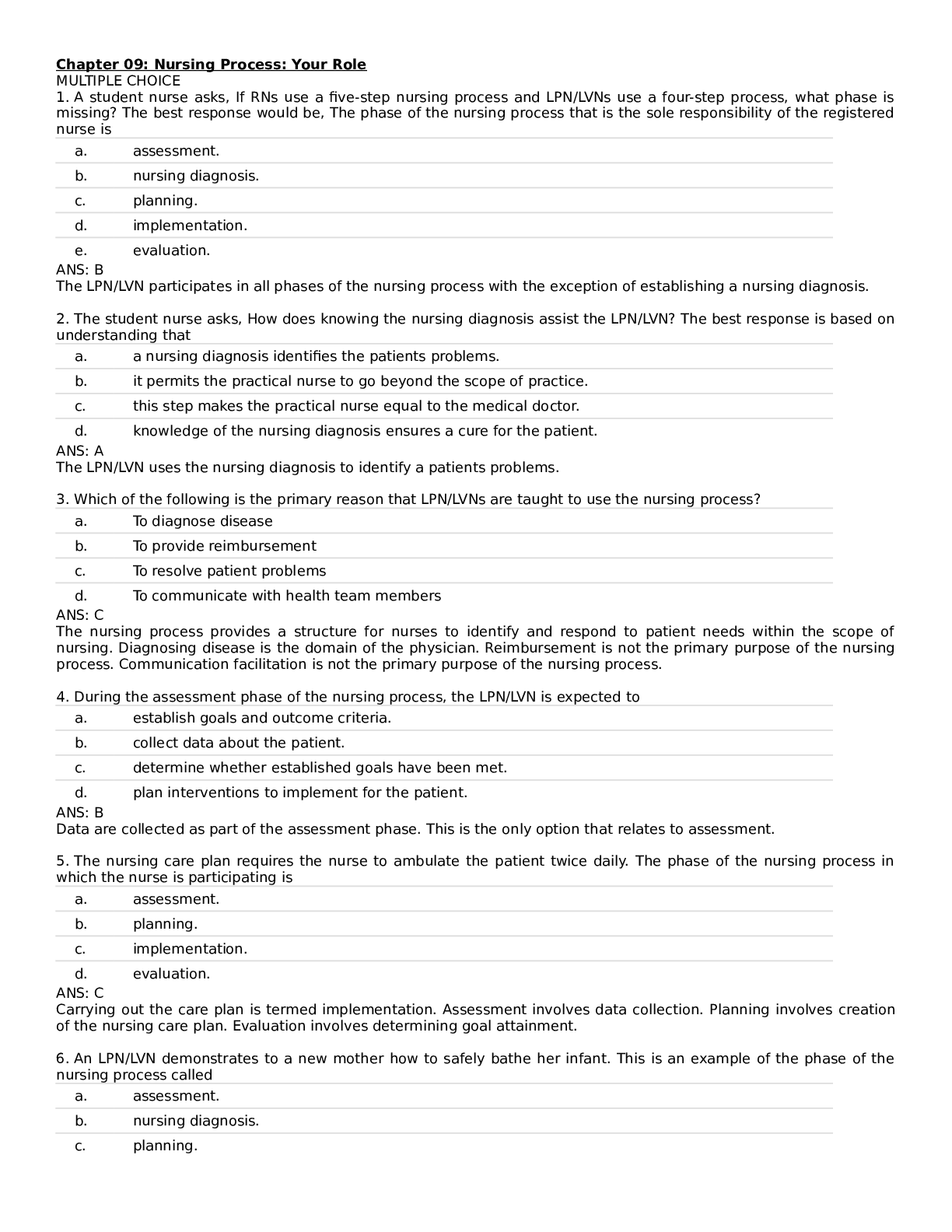
Reviews( 1 )

by Alabama588 · 2 years ago
Great info! Instant download.
Recommended For You
*NURSING> QUESTIONS & ANSWERS > HESI Exam A Questions & Answers & Rationale (2019/2020) Complete A+ Guide. (All)
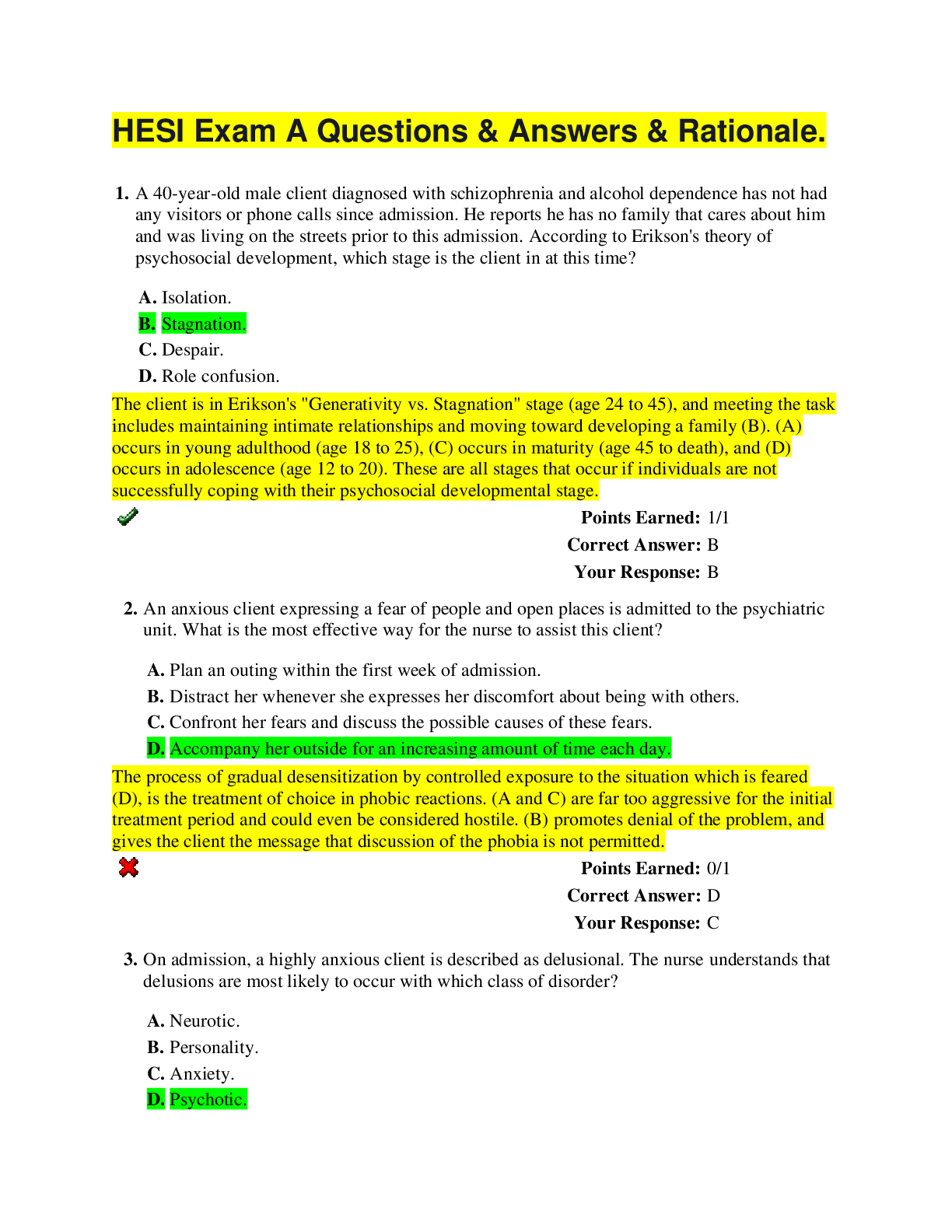
HESI Exam A Questions & Answers & Rationale (2019/2020) Complete A+ Guide.
HESI Exam A Questions & Answers & Rationale. 1. A 40-year-old male client diagnosed with schizophrenia and alcohol dependence has not had any visitors or phone calls since admission. He reports he ha...
By Expert1 , Uploaded: Jun 26, 2020
$18
*NURSING> QUESTIONS & ANSWERS > NR 508|Advanced Pharmacology Final Exam Test Bank| Complete A+ Guide Solutions. (All)
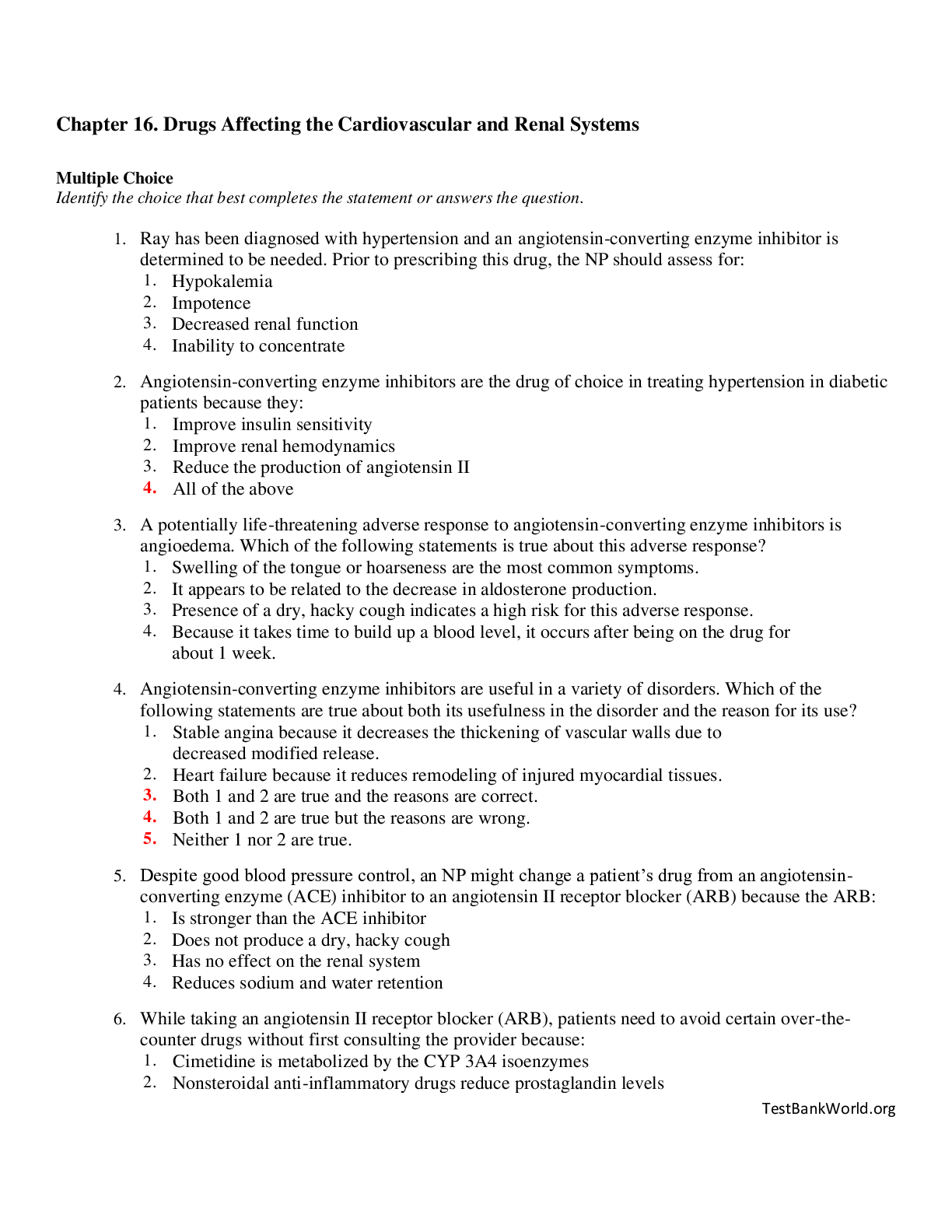
NR 508|Advanced Pharmacology Final Exam Test Bank| Complete A+ Guide Solutions.
Chapter 16. Drugs Affecting the Cardiovascular and Renal Systems Multiple Choice Identify the choice that best completes the statement or answers the question. 1. Ray has been diagnosed with h...
By Expert#1 , Uploaded: May 25, 2020
$25
*NURSING> QUESTIONS & ANSWERS > PCT test Davita (Study Guide) complete A+ guide, updated fall 2021/2022. (All)
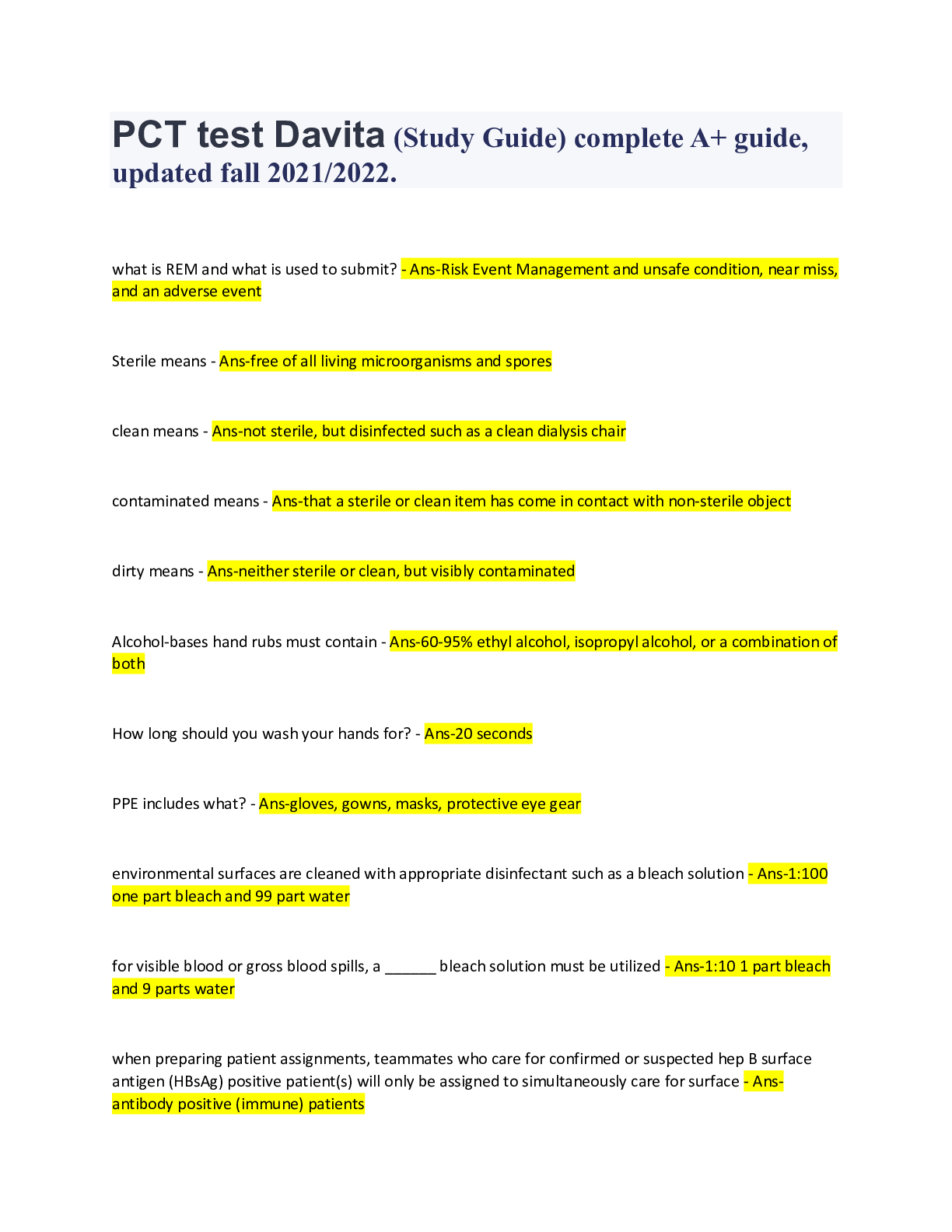
PCT test Davita (Study Guide) complete A+ guide, updated fall 2021/2022.
e, updated fall 2021/2022. what is REM and what is used to submit? - Ans-Risk Event Management and unsafe condition, near miss, and an adverse event Sterile means - Ans-free of all living microorg...
By Professor Lynne , Uploaded: Jun 27, 2022
$10
*NURSING> QUESTIONS & ANSWERS > PCT test Davita (Study Guide) complete A+ guide, updated fall 2021/2022 (All)

PCT test Davita (Study Guide) complete A+ guide, updated fall 2021/2022
PCT test Davita (Study Guide) complete A+ guide, updated fall 2021/2022. what is REM and what is used to submit? - Ans-Risk Event Management and unsafe condition, near miss, and an adverse event S...
By Nutmegs , Uploaded: Jun 19, 2022
$10
*NURSING> QUESTIONS & ANSWERS > PCT test Davita (Study Guide) complete A+ guide, updated fall 2021/2022. (All)

PCT test Davita (Study Guide) complete A+ guide, updated fall 2021/2022.
what is REM and what is used to submit? - Ans-Risk Event Management and unsafe condition, near miss, and an adverse event Sterile means - Ans-free of all living microorganisms and spores clean m...
By bundleHub Solution guider , Uploaded: Jun 14, 2022
$10
*NURSING> QUESTIONS & ANSWERS > FNP Pediatric Exam Bank; complete A+ guide latest fall 2022/2023 (All)

FNP Pediatric Exam Bank; complete A+ guide latest fall 2022/2023
FNP Pediatric Exam Bank; complete A+ guide latest fall 2022/2023
By luzlinkuz , Uploaded: Jun 13, 2022
$12
*NURSING> QUESTIONS & ANSWERS > RN Exam A Questions & Answers & Rationale (2019/2020) Complete A+ Guide. (All)
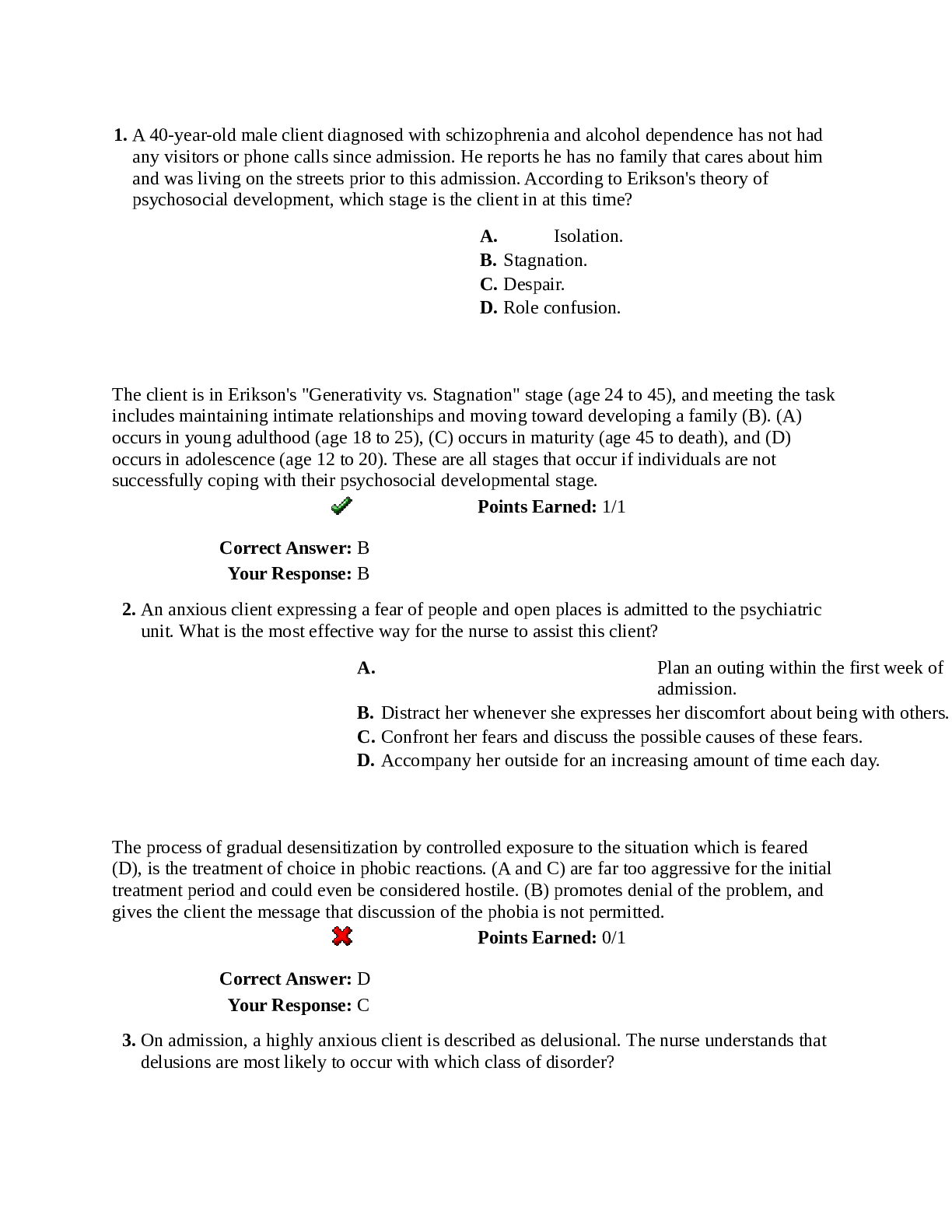
RN Exam A Questions & Answers & Rationale (2019/2020) Complete A+ Guide.
1. A 40-year-old male client diagnosed with schizophrenia and alcohol dependence has not had any visitors or phone calls since admission. He reports he has no family that cares about him and was liv...
By Nutmegs , Uploaded: May 05, 2022
$13.5
*NURSING> QUESTIONS & ANSWERS > University of Phoenix NAPSRX Test Questions and Answers Complete A+ Guide (All)

University of Phoenix NAPSRX Test Questions and Answers Complete A+ Guide
NAPSRX Test 1.How are drugs sorted into therapeutic groups and classes? A. first by the conditions that they are used to treat, and then by their mechanisms of action B. first by their mechanisms...
By Nutmegs , Uploaded: Apr 05, 2022
$13
*NURSING> QUESTIONS & ANSWERS > NUR 2349 : Med Surg Exam 1, Latest 2021/22 complete A+ guide, Rasmussen College. (All)
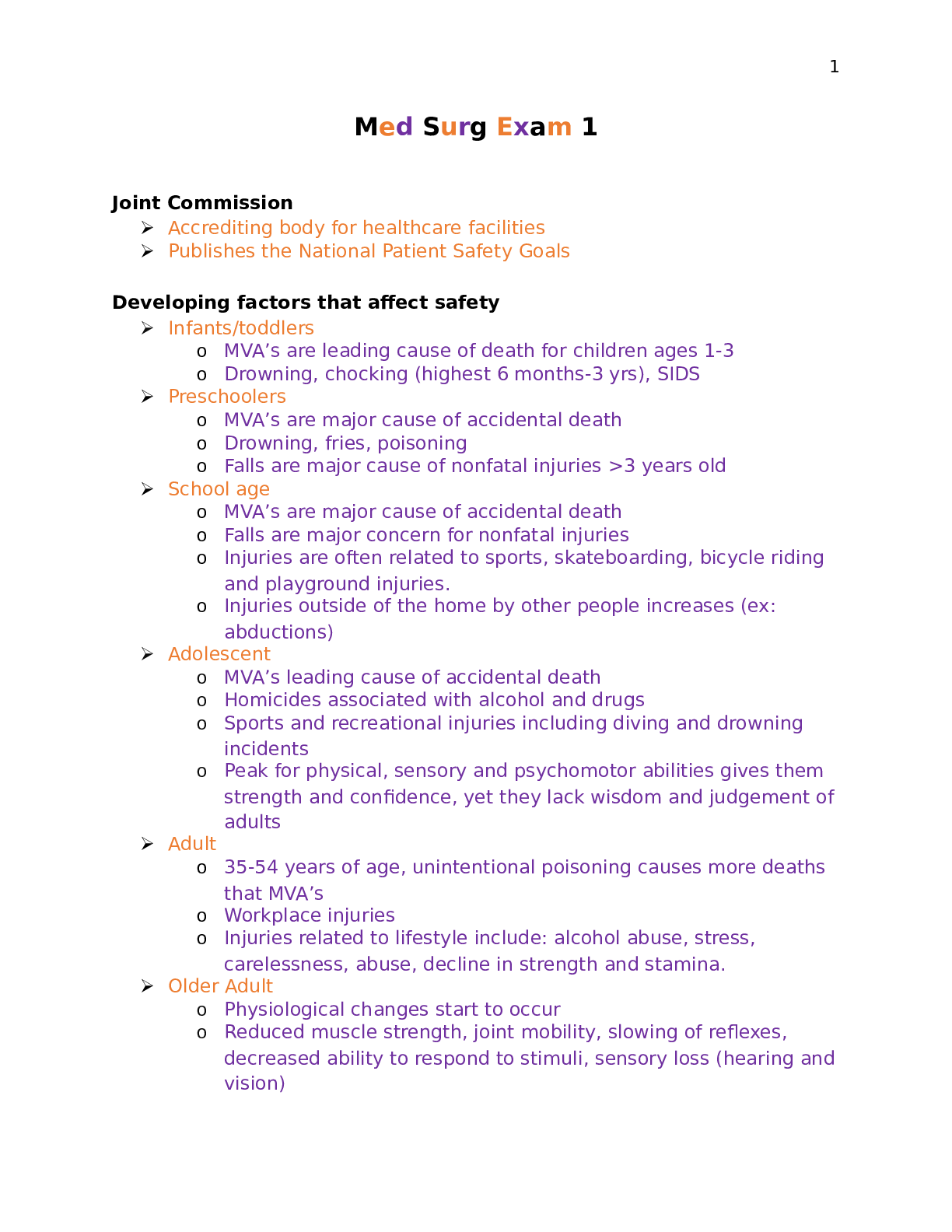
NUR 2349 : Med Surg Exam 1, Latest 2021/22 complete A+ guide, Rasmussen College.
Med Surg Exam 1 Joint Commission Accrediting body for healthcare facilities Publishes the National Patient Safety Goals Developing factors that affect safety Infants/toddlers o MVA’s are l...
By Nutmegs , Uploaded: Apr 03, 2022
$13
*NURSING> QUESTIONS & ANSWERS > NR 511|NR511 Midterm Exam Study Guide; Updated (2020) Complete A+ guide. ALL YOU NEED. (WEEK 1 TO WEEK 6) (All)

NR 511|NR511 Midterm Exam Study Guide; Updated (2020) Complete A+ guide. ALL YOU NEED. (WEEK 1 TO WEEK 6)
NR 511 Midterm Exam Study Guide NR 511 Week 1 1. Define diagnostic reasoning 2. Discuss and identify subjective & objective data 3. Discuss and identify the components of the HPI 4. Describe the diffe...
By Book Worm, Certified , Uploaded: Oct 29, 2021
$16
Document information
Connected school, study & course
About the document
Uploaded On
Dec 21, 2020
Number of pages
43
Written in
Additional information
This document has been written for:
Uploaded
Dec 21, 2020
Downloads
1
Views
124





